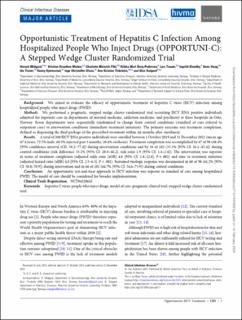| dc.contributor.author | Midgard, Håvard | |
| dc.contributor.author | Malme, Kristian Braathen | |
| dc.contributor.author | Pihl, Charlotte Meinich | |
| dc.contributor.author | Berg-Pedersen, Riikka Mari | |
| dc.contributor.author | Tanum, Lars Håkon Reiestad | |
| dc.contributor.author | Klundby, Ingvild | |
| dc.contributor.author | Haug, Anne | |
| dc.contributor.author | Tveter, Ida Giæver | |
| dc.contributor.author | Bjørnestad, Ronny | |
| dc.contributor.author | Olsen, Inge Christoffer | |
| dc.contributor.author | Finbråten, Ane-Kristine | |
| dc.contributor.author | Dalgard, Olav | |
| dc.date.accessioned | 2024-02-21T12:03:35Z | |
| dc.date.available | 2024-02-21T12:03:35Z | |
| dc.date.created | 2024-02-15T14:40:48Z | |
| dc.date.issued | 2023 | |
| dc.identifier.citation | Clinical Infectious Diseases. 2023, . | en_US |
| dc.identifier.issn | 1058-4838 | |
| dc.identifier.uri | https://hdl.handle.net/11250/3119000 | |
| dc.description.abstract | Background. We aimed to evaluate the efficacy of opportunistic treatment of hepatitis C virus (HCV) infection among hospitalized people who inject drugs (PWID).
Methods. We performed a pragmatic, stepped wedge cluster randomized trial recruiting HCV RNA positive individuals admitted for inpatient care in departments of internal medicine, addiction medicine, and psychiatry at three hospitals in Oslo, Norway. Seven departments were sequentially randomized to change from control conditions (standard of care referral to outpatient care) to intervention conditions (immediate treatment initiation). The primary outcome was treatment completion, defined as dispensing the final package of the prescribed treatment within six months after enrolment.
Results. A total of 200 HCV RNA positive individuals were enrolled between 1 October 2019 and 31 December 2021 (mean age 47.4 years, 72.5% male, 60.5% injected past 3 months, 20.4% cirrhosis). Treatment completion was accomplished by 67 of 98 (68.4% [95% confidence interval {CI}: 58.2–77.4]) during intervention conditions and by 36 of 102 (35.3% [95% CI: 26.1–45.4]) during control conditions (risk difference 33.1% [95% CI: 20.0–46.2]; risk ratio 1.9 [95% CI: 1.4–2.6]). The intervention was superior in terms of treatment completion (adjusted odds ratio [aOR] 4.8 [95% CI: 1.8–12.8]; P = .002) and time to treatment initiation (adjusted hazard ratio [aHR] 4.0 [95% CI: 2.5–6.3]; P < .001). Sustained virologic response was documented in 60 of 98 (61.2% [95% CI: 50.8–70.9]) during intervention and in 66 of 102 (64.7% [95% CI: 54.6–73.9]) during control conditions.
Conclusions. An opportunistic test-and-treat approach to HCV infection was superior to standard of care among hospitalized PWID. The model of care should be considered for broader implementation.
Clinical Trials Registration. NCT04220645
Keywords. hepatitis C virus; people who inject drugs; model of care; pragmatic clinical trial; stepped wedge cluster randomized trial. | en_US |
| dc.language.iso | eng | en_US |
| dc.rights | Navngivelse 4.0 Internasjonal | * |
| dc.rights.uri | http://creativecommons.org/licenses/by/4.0/deed.no | * |
| dc.title | Opportunistic Treatment of Hepatitis C Infection Among Hospitalized People Who Inject Drugs (OPPORTUNI-C): A Stepped Wedge Cluster Randomized Trial | en_US |
| dc.type | Journal article | en_US |
| dc.type | Peer reviewed | en_US |
| dc.description.version | publishedVersion | en_US |
| cristin.ispublished | true | |
| cristin.fulltext | original | |
| cristin.qualitycode | 2 | |
| dc.identifier.doi | 10.1093/cid/ciad711 | |
| dc.identifier.cristin | 2246487 | |
| dc.source.journal | Clinical Infectious Diseases | en_US |
| dc.source.pagenumber | 9 | en_US |
| dc.relation.project | Helse Sør-Øst RHF: 2020011 | en_US |

